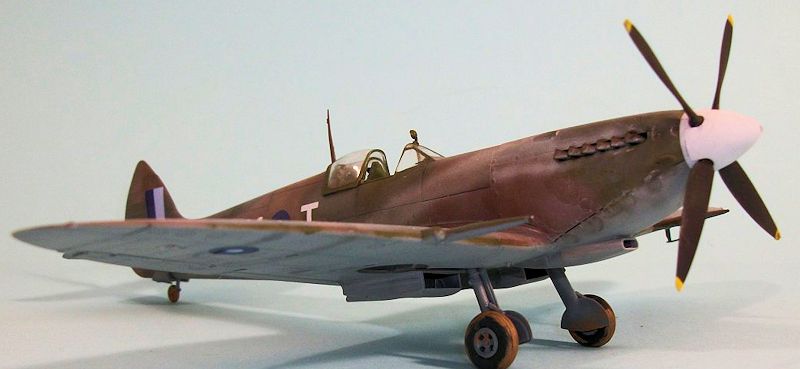
Eduard 1/48 Spitfire VIII
| KIT #: | 8284 |
| PRICE: | 4140 yen at www.hlj.com |
| DECALS: | Six options |
| REVIEWER: | Tom Cleaver |
| NOTES: | Barracuda Decals 48008 “Spitfire VIII Part 1" |

| HISTORY |
While the Spitfire IX was both better-known and produced in far
larger numbers, the Spitfire VIII represents the high-point of
development of the Merlin-powered Spitfire variants.
Basically an unpressurized Mk.VII, the Spitfire VIII had all the
refinements of the first major redesign of the Spitfire since the Mk.I
(The Spitfire V was an “interim” development of a beefed-up Mk.I to take
a more powerful engine, while the Spitfire IX was an “interim”
development of the Mk.V, again to take a more powerful engine.)
The Mk.VIII had a strengthened fuselage, reduced-span ailerons,
enlarged rudder, increased armor protection, a retractable tailwheel,
and additional fuel in two 14-gallon tanks in the wing leading edge, in
addition to the Merlin 60-series engine with two-speed supercharger,
with all aircraft equipped with the Aero-Vee filter.
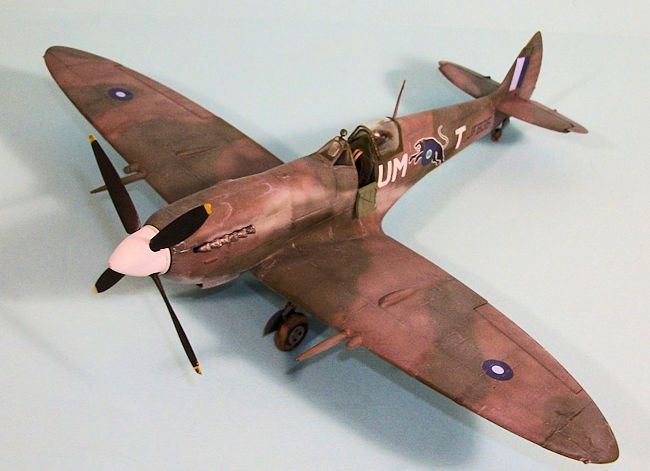 Production of the Spitfure VIII commenced in late 1942, with all
aircraft shipped overseas.
Initial deliveries were to units in the Mediterranean.
Once production built up in 1943, additional deliveries were made
to RAF units in India andRAAF units in Australia; these Spitfire VIIIs
were operated in first-line service until the end of the war.
Seven Spitfire VIIIs were issued to the 31st Fighter Group in
Italy in late 1943.
Production of the Spitfure VIII commenced in late 1942, with all
aircraft shipped overseas.
Initial deliveries were to units in the Mediterranean.
Once production built up in 1943, additional deliveries were made
to RAF units in India andRAAF units in Australia; these Spitfire VIIIs
were operated in first-line service until the end of the war.
Seven Spitfire VIIIs were issued to the 31st Fighter Group in
Italy in late 1943.
Up to September 1943, the Hurricane II and Mohawk IV had b been
the primary fighter types in Southeast Asia Command (SEAC, based
primarily in eastern India (what is today Bangladesh).
The first Spitfire Vc fighters arrived in September 1943 and
equipped Hurricane squadrons that passed their aircraft on to replace
the Mohawks.
The Spitfires
provided air defense for Calcutta, and were also used in the escort role
for RAF operations over Burma with Vultee Vengeance dive bombers.
The Spitfires were the first Allied fighters in the
China-Burma-India theater that could catch and shoot down the Mitsubishi
Ki.46 “Dinah” reconnaissance aircraft.
In preparation for the Arakan Offensive 81 and 152 Squadrons were
transferred to India from Italy in December 1943.
Once in India, they were re-equipped with the first Spitfire VIII
fighters to arrive.
Seven-victory ace Flying Officer Alan Peart of 81 Squadron recalled the
Spitfire VIII thus: “The Mark VIII Spitfire was a really beautiful
machine.
It had a
retractable tailwheel, clean lines and a pointed tail.
The Stromberg carburetor permitted negative Gs without the engine
cutting,and it had a two-stage supercharger that gave us considerable
additional power above 18,000 feet.
In the Arakan fighting, we
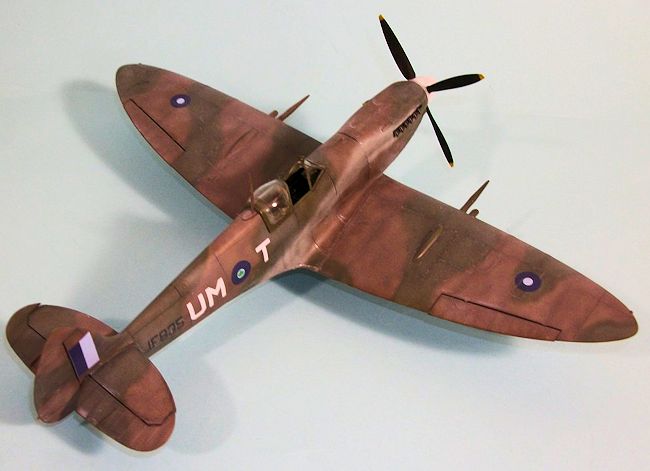 met the in force in our new mark
VIIIs, and within a few days the Japanese suffered severe fighter losses
that curtailed their normal aggressiveness.
Up until then, enemy aircraft appeared to roam, at will over
Allied territory.”
met the in force in our new mark
VIIIs, and within a few days the Japanese suffered severe fighter losses
that curtailed their normal aggressiveness.
Up until then, enemy aircraft appeared to roam, at will over
Allied territory.”
152 Squadron became operational at Calcutta in mid-December 1943,
and scored the first Spitfire VIII victory in the CBI on December 26,
1943, when two Spitfires flown by Flying Officer R.E.J. Macdonald and
Flight Sergeant R.O.J. Patterson intercepted and shot down a “Dinah.”
On New Year’s Day 1944, more Spitfire VIIIs re-equipped the
squadrons flying the Spitfire Vc. 155 Squadron gave up its status as the
last to fly the Mohawk IV when they received Spitfire VIIIs.
On January 15, 1944, the 64th Sentai reappeared and made three
separate sweeps over the Arakan battlefield.
The Japanese were met by Spitfire VIIIs, which decimated the
Ki.43 Oscars the unit was flying in some very spectacular dogfights.
In February, the Japanese launched their last offensive in the
CBI, Operation Ha-Go, the invasion of India.
There was increased aerial activity, with Spitfires meeting the
Ki.44 Tojo in combat for the first time.
In sharp-turning fights, the Spitfire pilots came back to base
with the high-altitude wingtips of the Spitfire VIIIs wrinkled, with a
couple extra degrees of dihedral.
The high altitude tips were quickly replaced with the standard
wingtips.
Once the Japanese were held in t he Arakan in late February,
fighting moved into Imphal in March.
Operation Thursday saw Orde Wingate’s Chindits enter combat
behind enemy lines at the “Broadway” and “Piccadily” airfields in an
attempt to slow down the Japanese advance at Imphal and Kohima.
The
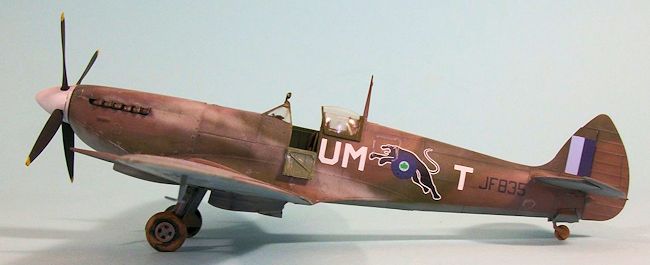 decisive phase of the Burma campaign b egan on March 8 when
the Japanese attacked Imphal.
81 Squadron had a detachment of Spitfires at “Broadway” airfield,
where they were successful in intercepting and destroying Japanese
aircraft.
On March 13, 40
Ki.43s appeared over Broadway.
In a fight lasting 45 minutes, the 81 Squadron Spitfires shot
down 4 and damaged 6 others, despite being outnumbered.
RAAF Flying Officer Larry Cronin was bounced by 8 Ki.43s as he
raised his landing gear getting off Broadway and only escaped by wild
flying over the jungle in which he scored his fifth victory.
On March 17, 81 Sqwuadron had their last fight at Broadway when
the detachment was again surprised by Ki.43s.
The squadron CO, Squadron Leader Whitamore, was killed in combat,
and flying Officer Alan Peart had the fight of his life at low altitude
for 40 minutes, during which he scored his fifth victory.
decisive phase of the Burma campaign b egan on March 8 when
the Japanese attacked Imphal.
81 Squadron had a detachment of Spitfires at “Broadway” airfield,
where they were successful in intercepting and destroying Japanese
aircraft.
On March 13, 40
Ki.43s appeared over Broadway.
In a fight lasting 45 minutes, the 81 Squadron Spitfires shot
down 4 and damaged 6 others, despite being outnumbered.
RAAF Flying Officer Larry Cronin was bounced by 8 Ki.43s as he
raised his landing gear getting off Broadway and only escaped by wild
flying over the jungle in which he scored his fifth victory.
On March 17, 81 Sqwuadron had their last fight at Broadway when
the detachment was again surprised by Ki.43s.
The squadron CO, Squadron Leader Whitamore, was killed in combat,
and flying Officer Alan Peart had the fight of his life at low altitude
for 40 minutes, during which he scored his fifth victory.
At the end of March, the Japanese surrounded the Imphal Valley,
which could now only be re-supplied by air.
Ki.43s attacked formations of Dakota transports, which the
Spitfire VIIIs defended in several air battles.
Through most of April, the Spitfires engaged formations of
Japanese fighters on a daily basis.
The Spitfire VIII was faster and more heavily armed and armored
than the Ki.43, which was more maneuverable and generally outnumbered
the Spitfires in these fights.
May 1944 was the hardest month for air activity, despite the
deteriorating weather from the coming monsoon season.
152 Squadron finally saw sustained combat as the squadron
provided long ranger fighter escort for Vengeance dive-bomber missions
against the Japanese rear and in support of the Chindits.
Despite the onset of the monsoon, fighting in Imphal continued
into June.
On June 22, the
siege of Imphal was lifted and the Japanese began their retreat back to
Burma.
Having defeated the
JAAF in northern Burma, RAF figher units could now conduct offensive
work in support of ground forces.
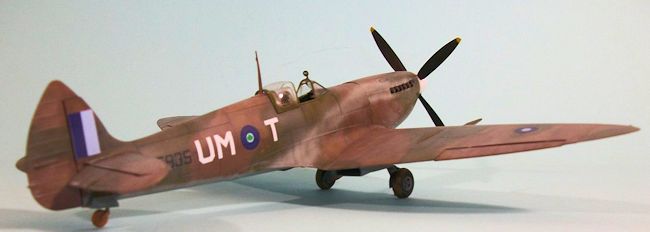 There would be little air combat during the monsoon, and
following the end of that in November, the Japanese forces in Burma were
greatly reduced, though air combat did continue on occasion to the end
of the war.
There would be little air combat during the monsoon, and
following the end of that in November, the Japanese forces in Burma were
greatly reduced, though air combat did continue on occasion to the end
of the war.
The real secret to RAF success in these battles was the Air
Fighting Training Unit, commanded by 28 victory Battle of Britain ace
Group Captain Frank Carey, whose instructors included such aces as
Flight Lieutenant “Ginger” Lacey, another Battle of Britain ace with 17
victories.
Small groups of
pilots would be brought to Carey’s “Top Gun” forerunner to be trained in
effective air combat tactics, which they took back to their squadrons.
The RAF official history stated “It was said that a remarkable
proportion of the enemy fighters brought down were destroyed by pilots
listening to the echo of Carey’s voice and obeying his teaching.”
| THE KIT |
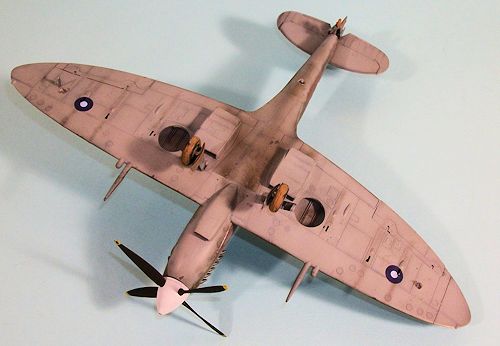 Eduard continues it release of the major marks of Merlin-60 Spitfires
with this Spitfire VIII.
The
kit features all-new wings with the reduced-span ailerons and the wing
leading edge tanks that were unique to this mark.
Additionally, the fuselage is new, with the retractable tail wheel.
As with all the other releases, the ailerons, elevators and rudder
are separate and can be posed dynamically.
The Profipack release includes a photo-etch fret with the instrument
panel, seatbelts, and radiators.
The kit comes with decals for six aircraft from Italy, India and
Australia.
The kit is the same
high quality as the previous Spitfire IX kits, with beautiful petite surface
detail, knife-edge trailing edges of wings and tail, and precise fit.
Eduard continues it release of the major marks of Merlin-60 Spitfires
with this Spitfire VIII.
The
kit features all-new wings with the reduced-span ailerons and the wing
leading edge tanks that were unique to this mark.
Additionally, the fuselage is new, with the retractable tail wheel.
As with all the other releases, the ailerons, elevators and rudder
are separate and can be posed dynamically.
The Profipack release includes a photo-etch fret with the instrument
panel, seatbelts, and radiators.
The kit comes with decals for six aircraft from Italy, India and
Australia.
The kit is the same
high quality as the previous Spitfire IX kits, with beautiful petite surface
detail, knife-edge trailing edges of wings and tail, and precise fit.
| CONSTRUCTION |
If you have built one of these Eduard Spitfires before, there are no
surprises here.
I painted and
assembled the cockpit, then the wing sub-assembly, then the fuselage,
brought the two major sub-assemblies together, then attacked the horizontal
stabilizer, elevators and rudder.
| COLORS & MARKINGS |
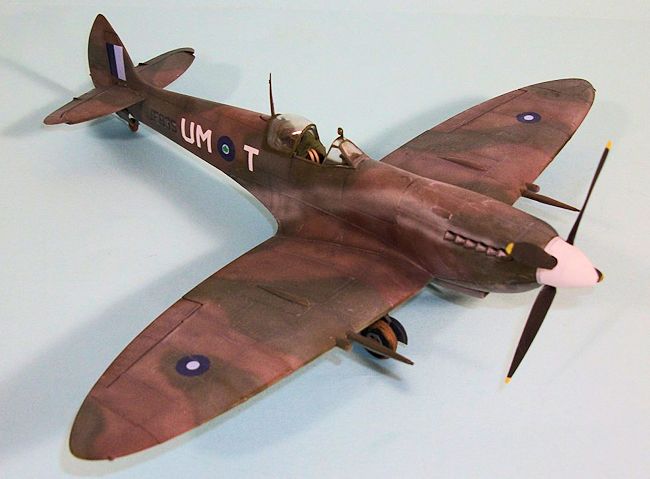
The decals went on without problem.
I didn’t use any of the stencil decals, since stenciling was not
reapplied to these airplanes after they went through the paint shops.
I unmasked the canopy and posed it in the open position.
I “muddied” the main gear and tailwheel.
| CONCLUSIONS |
Eduard’s Spitfires are the best Spitfires in any scale (unless you want
to open everything up, in which case the Tamiya 1/32 kit is what you want). The
Barracuda decal sheet provides some other interesting options, and is up to the
company’s standard of high quality. The Profipack kits offer good value for the
money, with ample extra marking options and photoetch details.
Follow the instructions and take your time and the result is fantastic.
Highly recommended.
Review kit courtesy of HobbyLink Japan.
Order yours
at this link.
July 2015
If you would like your product reviewed fairly and fairly quickly, please contact the editor or see other details in the Note to Contributors.